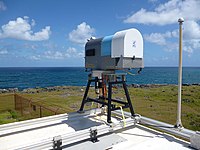
Photo from wikipedia
Abstract The Planetary Boundary Layer (PBL) is an important part of the atmosphere that is relevant in different atmospheric fields like pollutant dispersion, and weather forecasting. In this study, we… Click to show full abstract
Abstract The Planetary Boundary Layer (PBL) is an important part of the atmosphere that is relevant in different atmospheric fields like pollutant dispersion, and weather forecasting. In this study, we analyze four and five-year datasets of measurements gathered with a ceilometer and a microwave radiometer to study the PBL structure respectively, in the mid-latitude urban area of Granada (Spain). The methodologies applied for the PBL Height (PBLH) detection (gradient method for ceilometer and the combination of parcel method and temperature gradient method for microwave radiometer) provided a description in agreement with the literature about the PBL structure under simple scenarios. Then, the PBLH behavior is characterized by a statistical study of the convective and stable situations, so that the PBLH was obtained from microwave radiometer measurements. The analysis of the PBLH statistical study shows some agreement with other PBLH studies such as daily pattern and yearly cycle, and the discrepancies were explained in terms of distinct latitudes, topography and climate conditions. Finally, it was performed a joint long-term analysis of the residual layer (RL) provided by ceilometer and the stable and convective layer heights determined by microwave radiometer, offering a complete picture of the PBL evolution by synergetic combination of remote sensing techniques. The PBL behavior has been used for explaining the daily cycle of Black Carbon (BC) concentration, used as tracer of the pollutants emissions associated to traffic.
Journal Title: Atmospheric Research
Year Published: 2020
Link to full text (if available)
Share on Social Media: Sign Up to like & get
recommendations!